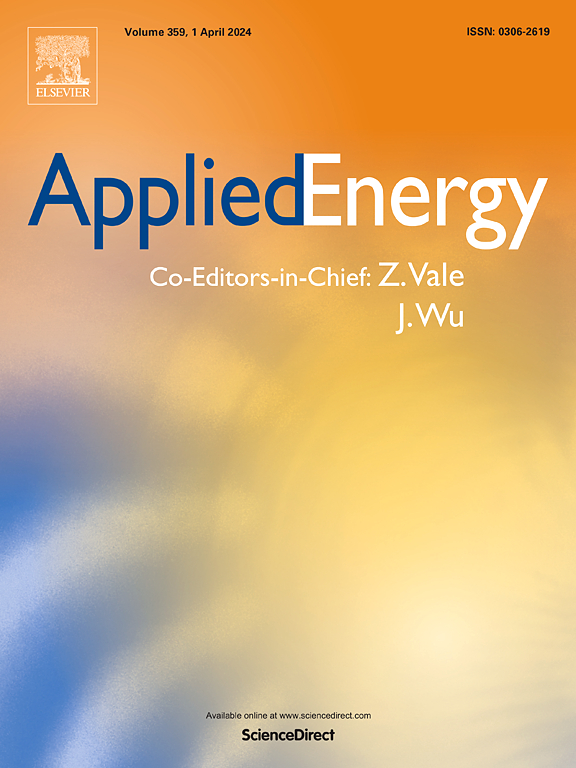在碳排放限制下,麦秸制甲醇船用燃料的潜在解决方案:比较能源、能源、经济和环境分析
IF 11
1区 工程技术
Q1 ENERGY & FUELS
引用次数: 0
摘要
绿色甲醇作为一种可持续的船用替代燃料已经出现,但其产业化需要在碳排放限制下对技术路线进行系统评估。本研究对1号路线(部分并网发电)、2号路线(自产电)和3号路线(一体化制氢)三条麦秸制甲醇路线进行了过程建模和对比分析。1号路线采用电网供电,碳排放量为40.78 g CO2eq/MJ甲醇。2号线采用自产电,实现22.70 g CO2eq/MJ甲醇,与1号线采用可再生电时的水平相当。3号路线甲醇产率和能源效率最高,合成气调节的火用损失最小,但经济性最差。3号线的碳排放对可再生电力结构高度敏感。总的来说,1号公路使用电网是不合适的。2号公路的碳排放和经济效益具有竞争力,是早期工业化的理想选择,特别是在可再生能源有限的地区。3号线最适合稻草丰富、可再生能源资源强的地区,建议分阶段实施1号线和3号线使用可再生电力。本研究为碳排放限制下的生物质制甲醇工业化提供了潜在的解决方案,为研究人员、投资者和行业利益相关者提供了数据支持和有价值的见解。本文章由计算机程序翻译,如有差异,请以英文原文为准。

Potential solution to wheat straw-to-methanol for marine fuel under carbon emission restrictions: A comparative energy, exergy, economic, and environmental analysis
Green methanol has emerged as a sustainable alternative marine fuel, yet its industrialization requires a systematic evaluation of technical routes under carbon emission restrictions. This study conducted process modeling and comparative analysis of three wheat straw-to-methanol routes: Route 1 (partial grid electricity), Route 2 (self-generated electricity), and Route 3 (integrated hydrogen production). Route 1, using grid electricity, resulted in a carbon emission of 40.78 g CO2eq/MJ methanol. Route 2, utilizing self-generated electricity, achieved 22.70 g CO2eq/MJ methanol, matching Route 1 when renewable electricity was used. Route 3 achieved the highest methanol yield and energy efficiency, with minimal exergy loss in syngas conditioning, but exhibited the poorest economic performance. Route 3's carbon emissions were highly sensitive to the renewable electricity structure. Overall, Route 1 using grid electricity was unsuitable. Route 2, with its competitive carbon emissions and economic performance, was ideal for early industrialization, especially in regions with limited renewable energy resources. Route 3 was best suited for areas with abundant straw and strong renewable energy resources, suggesting a phased implementation of Routes 1 and 3 using renewable electricity. This study provided potential solutions for the industrialization of biomass-to-methanol under carbon emission restrictions, offering data support and valuable insights for researchers, investors, and industry stakeholders.
求助全文
通过发布文献求助,成功后即可免费获取论文全文。
去求助
来源期刊

Applied Energy
工程技术-工程:化工
CiteScore
21.20
自引率
10.70%
发文量
1830
审稿时长
41 days
期刊介绍:
Applied Energy serves as a platform for sharing innovations, research, development, and demonstrations in energy conversion, conservation, and sustainable energy systems. The journal covers topics such as optimal energy resource use, environmental pollutant mitigation, and energy process analysis. It welcomes original papers, review articles, technical notes, and letters to the editor. Authors are encouraged to submit manuscripts that bridge the gap between research, development, and implementation. The journal addresses a wide spectrum of topics, including fossil and renewable energy technologies, energy economics, and environmental impacts. Applied Energy also explores modeling and forecasting, conservation strategies, and the social and economic implications of energy policies, including climate change mitigation. It is complemented by the open-access journal Advances in Applied Energy.
 求助内容:
求助内容: 应助结果提醒方式:
应助结果提醒方式:


